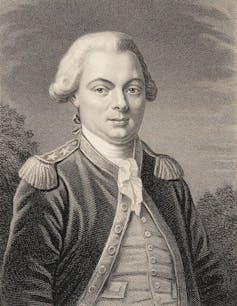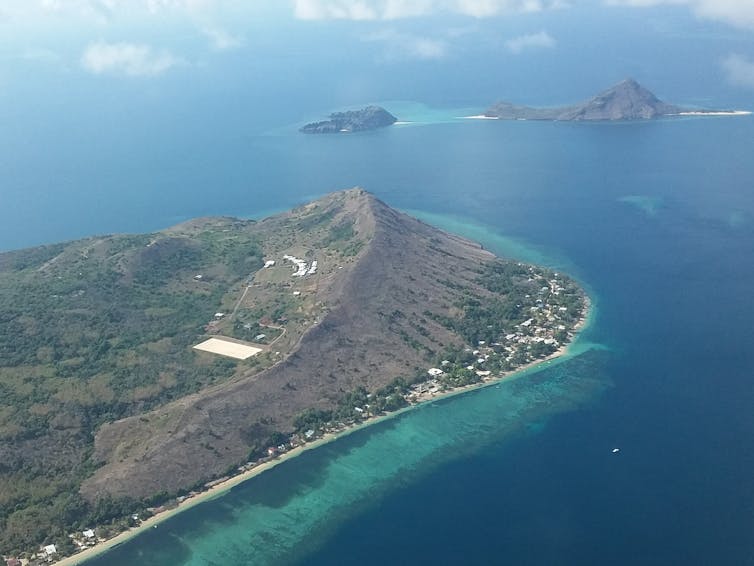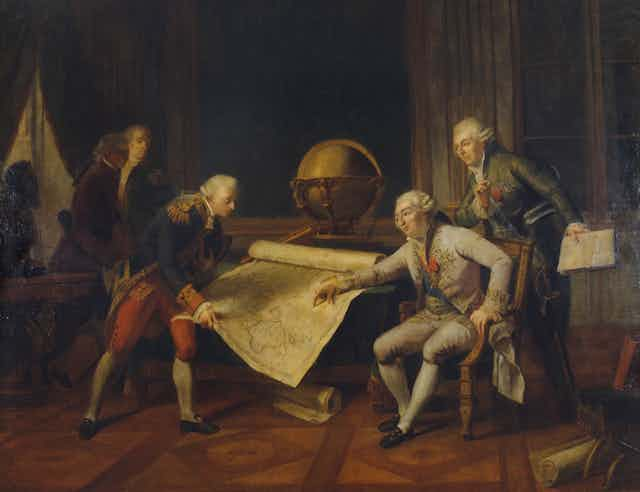The final fate of the expedition led by Jean-François de Galaup, Comte de La Pérouse, has been a mystery ever since the frigates L’Astrolabe and La Boussole sailed out of Botany Bay in March 1788, vanishing, it seemed, into the vastness of the Pacific.
The expedition left the French port of Brest in 1785. The two vessels, with a complement of 225 officers, crew and scientists, were crammed with supplies and trade goods for a four-year long Pacific voyage that sought to emulate the feats of discovery of Captain James Cook. King Louis XVI took a personal interest in the undertaking and helped draft the plans and itinerary.
Read more: When it comes to disappearing ocean history, HMAS Perth is the tip of the iceberg
La Pérouse also had orders to investigate the new British colony in Australia. He arrived off Botany Bay, New South Wales in January 1788 to see Arthur Philip’s First Fleet at anchor, and so witnessed the beginning of European settlement of the continent. For six weeks the French camped on the northern shores of the Bay: the area now home to the south-eastern Sydney suburb bearing his name.

Before departing Australia to continue his voyage, La Pérouse left letters with the British for forwarding to the French Naval Ministry. In them he detailed how he planned to leave the Pacific Ocean via Torres Strait, the narrow waterway separating Australia and New Guinea, and be back in France by June 1789. Concern mounted when they did not arrive as expected. In 1791 the French National Assembly commissioned an expedition to search for the overdue navigator, without success. It is said that King Louis XVI, on his way to the guillotine in 1793, enquired of his captors “Is there news of La Pérouse?”
A dogged Irish captain finally solved the puzzle almost four decades later. In 1826 Peter Dillon saw European objects at Tikopia in the Solomon Islands, which locals told him came from a nearby island called Vanikoro. He suspected they were from La Pérouse’s ships. Eventually, he was given command of the survey vessel Research and arrived at Vanikoro in 1827, going on to learn the awful fate of L’Astrolabe and La Boussole: both frigates had smashed against the island’s fringing reef during a storm. Artefacts collected by Dillon were taken to Paris where they were identified as belonging to the expedition vessels.
The Vanikoro Islanders also related how survivors from Le Pérouse’s ships had spent several months constructing a small two-masted schooner, using timber salvaged from wreckage and hewn from the island’s dense forests. Once completed, they launched the vessel and sailed away.
What became of this vessel and its crew, desperate to return to France, has been an ongoing mystery. Subsequent books and articles about La Pérouse have asked the same questions: did the vessel even make it out of the Vanikoro lagoon, or was it attacked by locals in canoes? If it did get away, did it founder and sink beneath the waves? Or did the survivors die of thirst or starvation at sea? Or did they again suffer shipwreck elsewhere in the Pacific?
Read more: Transit of Venus: a tale of two expeditions
An Indian newspaper article from 1818 can perhaps shed light on the fate of the Vanikoro escape vessel. The December 1818 issue of The Madras Courier related how, in September that year, the ships Claudine and Mary, bound for Calcutta from Sydney, anchored off Murray Island in the Torres Strait Islands. There they rescued a castaway Indian seaman, Shaik Jumaul, who had survived the sinking of the merchant ship Morning Star four years earlier off the north Queensland coast.
On board the Mary, Shaik Jumaul was interviewed about his experiences on the island. He reported that he had seen swords and muskets on the islands, “differently made from English”, as well as a compass and a gold watch. When he asked the Islanders where they had obtained these things, an old man explained how thirty years earlier a ship was wrecked on the Great Barrier Reef, within sight of Murray Island. White men had come from her in boats, but in the fighting that followed all were killed except a boy, who was spared and brought up as one of their own.

The expedition crew list includes a ship’s boy, François Mordelle, from the port town of Tréguier in Brittany, northwestern France. Could this be last survivor of the La Pérouse expedition?
The article featuring the castaway’s account was reproduced in several other newspapers of the day, in Australia, Britain, France and other countries, and observers noted that this might refer to the La Pérouse expedition. Somehow, Shaik Jamaul’s story was largely forgotten in subsequent years.
The chronology fits nicely, for it was 30 years earlier, in late 1788 or early 1789, that the La Pérouse survivors departed Vanikoro in their small vessel. Furthermore, historians are not aware of any other European ship in the region at that time.
Torres Strait, which includes the northern part of Australia’s Great Barrier Reef, is studded with reefs, rocks and sandbars. It has been described as a “graveyard of ships”, as over 120 vessels are known to have come to grief in its treacherous waters. The vessel reported by Shaik Jumaul is the earliest known shipwreck in the Strait and indeed, eastern Australia.
Could it be that the final phase of the La Pérouse expedition ended in tragedy in northern Australia? Future recovery of artefacts from the wreck site on the Great Barrier Reef – yet to be discovered – or the islands, will hopefully provide final confirmation.
One La Pérouse mystery, however, will likely remain unsolved.
The Murray Islanders showed Shaik Jamaul the young castaway’s clothing, and cried as they recalled how he, together with two young girls, left the island one night in a canoe. His island friends searched for them, but they were never seen again. Was he seeking to return to France? Did he suffer an accident at sea? Or was he shipwrecked elsewhere a third and final time?
A last crewman, a survivor, a castaway. Though his identity and fate are unknown, he is not lost to memory.


